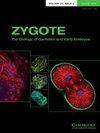实时图像和延时技术选择单个囊胚在辅助生殖周期中转移。
IF 1.5
4区 生物学
Q4 CELL BIOLOGY
引用次数: 2
摘要
辅助生殖周期的成功应该是在替换一个胚胎后实现健康的单胎活产。因此,选择标准和如何选择具有高着床潜力的最佳胚胎进行移植一直是胚胎学家最关键的问题之一。在这种情况下,形态学评价一直是历史上应用的方法。然而,这种做法依赖于有限数量的单次观测,并且与操作员的高可变性有关。最近,胚胎培养的一项重大创新是引入了一种具有集成延时监测的新型培养箱,使胚胎学家能够分析胚胎发育的动态事件,从受精到囊胚形成。这种新颖的做法正在迅速发展,并已在世界各地的许多试管婴儿诊所实施。因此,本综述的主要目的是说明延时技术在现代胚胎学实验室的好处。我们特别讨论了囊胚塌陷事件和囊胚形态评估,并分析了它们与胚胎活力和着床潜力的关系。本文章由计算机程序翻译,如有差异,请以英文原文为准。
Real-time image and time-lapse technology to select the single blastocyst to transfer in assisted reproductive cycles.
The success of an assisted reproduction cycle should be the achievement of a healthy singleton live birth following the replacement of one embryo. Therefore, one of the most critical points for embryologists has been the selection criteria and how to choose the best embryo to transfer with high implantation potential. In this vein, morphological evaluation has been historically the method applied. However, this practice relies on a limited number of single observations and is associated with high operator variability. Recently, a major innovation in embryo culture has been the introduction of a new type of incubator with integrated time-lapse monitoring, which enables the embryologist to analyze the dynamic events of embryo development, from fertilization to blastocyst formation. This novel practice is quickly growing and has been implemented in many IVF clinics worldwide. Therefore, the main aim of this review is to illustrate the benefits of time-lapse technology in a modern embryology laboratory. In particular, we discuss the blastocyst collapse(s) event and morphometric blastocyst assessment and analyse their association with embryo viability and implantation potential.
求助全文
通过发布文献求助,成功后即可免费获取论文全文。
去求助
来源期刊

Zygote
生物-发育生物学
CiteScore
1.70
自引率
5.90%
发文量
117
审稿时长
6-12 weeks
期刊介绍:
An international journal dedicated to the rapid publication of original research in early embryology, Zygote covers interdisciplinary studies on gametogenesis through fertilization to gastrulation in animals and humans. The scope has been expanded to include clinical papers, molecular and developmental genetics. The editors will favour work describing fundamental processes in the cellular and molecular mechanisms of animal development, and, in particular, the identification of unifying principles in biology. Nonetheless, new technologies, review articles, debates and letters will become a prominent feature.
 求助内容:
求助内容: 应助结果提醒方式:
应助结果提醒方式:


